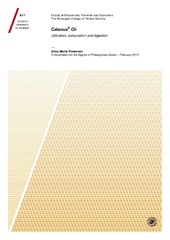| dc.contributor.advisor | Olsen, Ragnar Ludvig | |
| dc.contributor.author | Pedersen, Alice Marie | |
| dc.date.accessioned | 2016-09-28T12:50:04Z | |
| dc.date.available | 2016-09-28T12:50:04Z | |
| dc.date.issued | 2016-07-03 | |
| dc.description.abstract | In the pelagic system, phytoplankton are the main producers of n-3 LC-PUFA and make up the foundation of the oceanic food web. Zooplankton, such as copepods and krill, are the most numerous primary consumers in the marine environment and have a central role in the energy transfer to higher trophic levels. The copepod Calanus finmarchicus is present in large amounts in the North Atlantic and has lipid-rich stages that can be harvested in a sustainable manner.
The aim of this thesis was to provide knowledge which could contribute to the commercial utilization of Calanus finmarchicus. The wax ester-rich oil may be used as an alternative lipid source to fish oil in feeds for aquaculture, leading to good growth and efficient nutrient utilization. Moreover, the oil can be used as a health promoting nutraceutical as several recent publications indicate that oil from C. finmarchicus may have beneficial health effects beyond those which may be ascribed to the intake of EPA and DHA alone. In this work it was investigated if the use of commercial proteolytic enzymes could improve oil recovery from C. finmarchicus in an industrial-like process, and to characterize the oil obtained. The results showed a substantially higher oil yield with the use of proteolytic enzymes compared to standard fish oil production technology. The main components of the oil extracted from C. finmarchicus are monoesters of long-chain fatty acids and fatty alcohols, namely wax esters. In addition, the oil is rich in the deep red antioxidant astaxanthin present mostly as di- and monoesters. The fatty acid moiety of the wax esters consists of high quantities of stearidonic acid (SDA, 18:4n-3), EPA and DHA, but also a considerable amount of monounsaturated fatty acids, especially gondoic acid (20:1n-9) and cetoleic acid (22:1n-11). The final part of the thesis was to study the digestion of wax esters in mice fed a high fat diet supplemented with 2% Calanus® Oil. The findings confirmed that the mice were able to digest and absorb the Calanus® Oil, as the fatty acid composition of the adipose tissue and liver reflected the enrichment with the marine wax esters. Feeding mice a high fat diet supplemented with a small amount of wax ester-oil reduced the body weight gain, in line with recent published studies. | en_US |
| dc.description.doctoraltype | ph.d. | en_US |
| dc.description.popularabstract | Et betydelig fokus på positive helseeffekter ved inntak av de langkjedede omega-3 fettsyrene eikosapentaensyre (EPA, 20:5n-3) og dokosaheksaensyre (DHA, 22:6n-3) har ført til økt etterspørsel av fiskeoljer. Tilgjengeligheten av marine oljer begrenses på grunn av strengere regulering av fiskeriene og en økt utnyttelse av pelagiske fiskearter direkte til human konsum. Det er ikke nok fiskeolje på verdensmarkedet for å dekke behovet til en økende befolkning og samtidig en økende akvakulturproduksjon. Dette har ført til et omfattende arbeid med å lete etter andre alternative, og ikke minst bærekraftige kilder som inneholder disse langkjedede omega-3 fettsyrene (n-3 LC-PUFA). Raudåte (Calanus finmarchicus) er det mest tallrike dyreplankton i Nord-atlanteren, og spiller en viktig rolle i energioverføringen oppover i næringskjeden. Raudåta er beskrevet som Norges største fornybare ressurs, med en årsproduksjon på mellom 100 og 200 millioner tonn. Nyutviklet industriell høstingsteknologi har gjort det mulig for bærekraftig utnyttelse av denne ressursen.
Hensikten med doktorgradsarbeidet var å framskaffe kunnskap som kunne bidra til den kommersielle utnyttelsen av raudåte. Studier har vist at olje fra raudåte kan benyttes til fiskefôr i oppdrettsindustrien, hvor fisken utnytter næringsstoffene effektivt og vokser tilfredsstillende. Calanusolje kan også benyttes til humant konsum og finnes i dag tilgengelig som et kosttilskudd. Nylige prekliniske studier peker mot positive helseeffekter av Calanusolje utover det som vanligvis kan forklares ved inntak av omega-3 fettsyrer alene. I dette doktorgradsarbeidet ble det undersøkt om bruk av proteolytiske enzymer i fremstillingen kunne bedre oljeutbyttet og sammensetningen i oljeproduktet ble karakterisert. Resultatene viser at bruk av enzymteknologi frembringer et atskillig høyere oljeutbytte sammenlignet med tradisjonell fiskeoljeproduksjon. Oljen som utvinnes fra raudåta består hovedsakelig av monoestere som er satt sammen av langkjedede fettsyrer og fettalkoholer, også kjent som voksestere. Calanusolje har et høyt innhold av omega-3 fettsyrene stearidonsyre (SDA, 18:4n-3), EPA og DHA, men også et betydelig innhold av enumettede fettsyrer, spesielt gadolensyre (20:1n-9) og cetolensyre (22:1n-11). Innholdet av den røde antioksidanten astaxanthin foreligger i all hovedsak som mono- og diestere, og det høye innholdet av astaxanthin bidrar formodentlig til den oksidative stabiliteten til Calanusoljen. Den siste delen av doktorgradsarbeidet bestod i å undersøke fordøyelse hos mus gitt en såkalt høyfettdiett tilsatt 2% Calanusolje. Fettsyresammensetning i fettvev og lever bekreftet at musene kunne fordøye og absorbere voksesterene tilført via fôret og det ble registrert en reduksjon i vektøkning hos dyrene som var i samsvar med det som er sett i tidligere arbeider. | en_US |
| dc.description.sponsorship | The Research Council of Norway providing The Industrial PhD. Scheme (NæringsPhD) and Calanus AS as employer. | en_US |
| dc.description | The papers I and II of this thesis are not available in Munin. <br>
Paper I: Pedersen, A. M., Vang, B., Olsen, R. L.: «Oil from Calanus
finmarchicus —Composition and Possible Use: A Review.” Available in <a href=http://dx.doi.org/10.1080/10498850.2012.741662> Journal of Aquatic Food Product Technology 2014, 23(6):633-646. </a>
<br>
Paper II: Vang, B., Pedersen, A.M., Olsen, R.L.: “Oil extraction From the
Copepod Calanus finmarchicus Using Proteolytic Enzymes.” Available in <a href=http://dx.doi.org/10.1080/10498850.2012.686008> Journal of Aquatic
Food Product Technology 2014, 22(6):619-628 </a> | en_US |
| dc.identifier.isbn | 978-82-8266-118-8 | |
| dc.identifier.uri | https://hdl.handle.net/10037/9759 | |
| dc.identifier.urn | URN:NBN:no-uit_munin_9219 | |
| dc.language.iso | eng | en_US |
| dc.publisher | UiT The Arctic University of Norway | en_US |
| dc.publisher | UiT Norges arktiske universitet | en_US |
| dc.rights.accessRights | openAccess | |
| dc.rights.holder | Copyright 2016 The Author(s) | |
| dc.rights.uri | https://creativecommons.org/licenses/by-nc-sa/3.0 | en_US |
| dc.rights | Attribution-NonCommercial-ShareAlike 3.0 Unported (CC BY-NC-SA 3.0) | en_US |
| dc.subject | VDP::Teknologi: 500::Næringsmiddelteknologi: 600 | en_US |
| dc.subject | VDP::Technology: 500::Food science and technology: 600 | en_US |
| dc.subject | VDP::Matematikk og Naturvitenskap: 400::Basale biofag: 470::Biokjemi: 476 | en_US |
| dc.subject | VDP::Mathematics and natural science: 400::Basic biosciences: 470::Biochemistry: 476 | en_US |
| dc.title | Calanus® Oil. Utilization, composition and digestion | en_US |
| dc.type | Doctoral thesis | en_US |
| dc.type | Doktorgradsavhandling | en_US |


 English
English norsk
norsk

